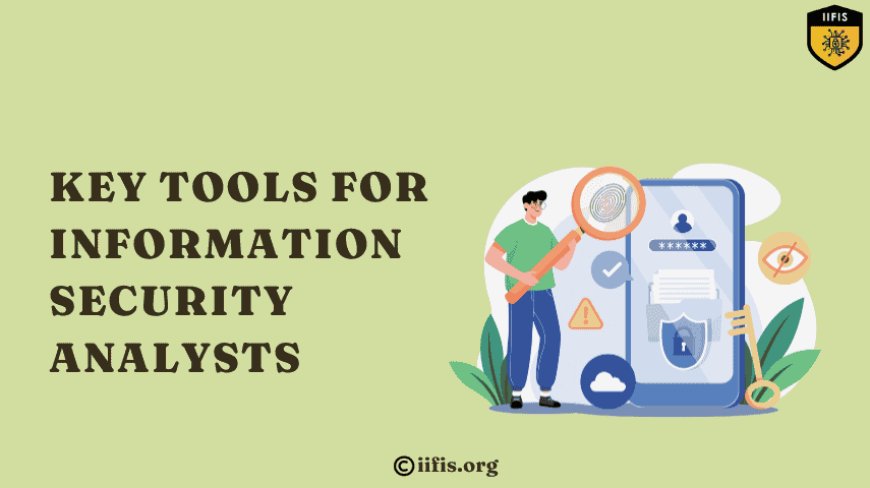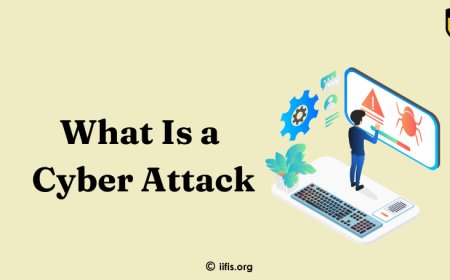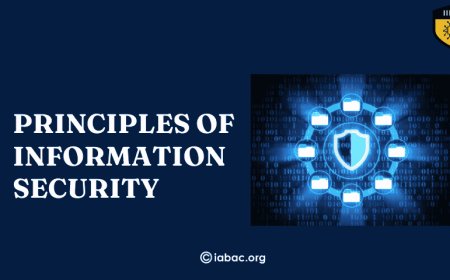Key Tools for Information Security Analysts
Discover essential tools for Information Security Analysts, including threat detection software, vulnerability scanners, SIEM systems, and more. Enhance security operations and protect your organization from cyber threats with the latest in cybersecurity technology.

information security analysts play a crucial role in protecting organizations from attacks and data breaches. To stay ahead of these threats, security analysts rely on a range of specialized tools that help them detect vulnerabilities, monitor systems, and respond to incidents effectively.This blog covers some of the key tools that information security analysts use daily, from threat detection and network monitoring to encryption and risk assessment. For anyone interested in cybersecurity or considering a career as a security analyst, understanding these tools is an important step in building the skills needed to keep data safe and secure.
Importance of Effective Tools in Information Security
In a world with increasing cyber threats, effective tools are essential for information security professionals. Cyber attacks are on the rise, exposing weaknesses across sectors and making data protection more challenging than ever.
With threats becoming more complex and attackers using advanced methods, security analysts need advanced tools to keep up. Basic measures are no longer enough, these modern challenges require tools that can detect, analyze, and respond to threats with accuracy and speed.
The right tools also allow security teams to be proactive. Instead of just responding to incidents after they occur, effective tools help analysts monitor systems in real-time, identify suspicious patterns early, and prevent breaches before they happen. By empowering analysts with efficiency and foresight, these tools play a key role in building a safer digital environment.
Categories of Essential Tools for Information Security Analysts
To keep data secure and prevent cyber threats, information security analysts rely on a range of tools. These tools can be grouped into several main categories, each serving a unique purpose in defending against attacks and monitoring for vulnerabilities.
-
Monitoring Tools: These tools keep an eye on network traffic, user activity, and system logs to spot any unusual behavior. Monitoring tools are essential for identifying early warning signs of potential attacks.
-
Detection Tools: Detection tools work to identify intrusions and malware as soon as they happen. They help analysts pinpoint specific threats quickly, allowing them to act before damage is done.
-
Threat Intelligence Tools: These tools gather and analyze information about potential and existing threats from a variety of sources. They provide insight into evolving attack patterns, which helps analysts stay prepared for the latest threats.
-
Incident Response Tools: When a security event does occur, incident response tools allow analysts to respond quickly and effectively. They help contain, investigate, and resolve security incidents to minimize impact and prevent recurrence.
-
Analysis Tools: These tools help analysts understand data from security events. Analysis tools support the investigation of patterns, root causes, and potential areas of vulnerability, leading to improved security strategies.
A comprehensive toolkit that covers these categories is crucial for an information security analyst. With tools for monitoring, detection, threat intelligence, incident response, and analysis, security professionals are better equipped to protect systems, respond to threats, and create stronger defense strategies.
Key Security Tools for Information Security Analysts
Information security analysts use a variety of tools to protect systems and data from cyber threats. Here’s an overview of some essential tools in their toolkit:
-
Intrusion Detection and Prevention Systems (IDPS)
IDPS tools are crucial for identifying and blocking suspicious activity. They monitor network traffic, detect potential attacks, and take action to prevent damage.
Examples: Snort, Suricata. -
Security Information and Event Management (SIEM) Systems
SIEM systems collect and analyze security event data in real time, providing alerts on unusual activity. They help analysts monitor, log, and investigate incidents across a network.
Examples: Splunk, LogRhythm. -
Vulnerability Scanners
Vulnerability scanners identify security weaknesses in networks, systems, and applications. They regularly scan for flaws that could be exploited, helping teams fix issues before they’re targeted by attackers.
Examples: Nessus, Qualys, OpenVAS. -
Endpoint Detection and Response (EDR) Tools
EDR tools focus on protecting individual devices (endpoints) like computers and mobile devices. They detect, investigate, and respond to threats, especially important for defending against malware and ransomware.
Examples: CrowdStrike Falcon, Carbon Black, SentinelOne. -
Threat Intelligence Platforms
These platforms gather and analyze information on emerging threats, providing insights that help organizations anticipate and prepare for new attack methods.
Examples: Recorded Future, ThreatConnect, Anomali. -
Network Traffic Analysis (NTA) Tools
NTA tools monitor and analyze network traffic, helping analysts spot unusual patterns that could indicate an attack. They’re essential for tracking what’s happening within a network.
Examples: Wireshark, SolarWinds NTA, Darktrace. -
Encryption Tools
Encryption tools protect data by converting it into unreadable code, ensuring that only authorized users can access sensitive information. Encryption is a fundamental measure for data privacy.
Examples: VeraCrypt, BitLocker, OpenSSL. -
Forensic Analysis Tools
Forensic tools are used after a breach to investigate what happened, helping analysts understand how an attack occurred and determine ways to prevent future incidents.
Examples: Autopsy, FTK (Forensic Toolkit), EnCase. -
Firewalls and Unified Threat Management (UTM) Solutions
Firewalls and UTM solutions act as a barrier between trusted and untrusted networks, blocking unauthorized access and filtering traffic. UTM combines multiple security features, like firewalls, anti-virus, and intrusion prevention, in a single tool.
Examples: Palo Alto Networks, Cisco ASA, Sophos UTM.
These tools, each with a unique role, equip information security analysts with the ability to monitor, detect, prevent, and respond to threats effectively, building a comprehensive approach to cybersecurity.
Criteria for Choosing Security Tools
Choosing the right security tools is essential for building a strong defense against cyber threats. Here are some key factors to consider when selecting tools for information security:
-
Scalability and Customization
Security needs can grow over time, so it’s important to choose tools that can adapt to your organization’s growth. A scalable tool can handle increased users, data, and traffic without a drop in performance, while customizable features let you tailor the tool to specific requirements. -
Ease of Use and Integration
Security tools should be easy to navigate and integrate smoothly with your existing systems. A user-friendly interface helps analysts work more efficiently, and strong integration capabilities allow the tool to work well with other software already in place, reducing compatibility issues. -
Budget Considerations
Balancing effectiveness with cost is important for any organization. While high-quality security tools are worth the investment, it’s essential to find options that fit within your budget. Look for tools that offer good value, considering both upfront costs and any ongoing expenses. -
Vendor Support and Community Resources
Reliable support is key when using security tools, especially in troubleshooting or addressing new threats. Strong vendor support, along with an active user community, can provide valuable resources, updates, and advice, making it easier to resolve issues and stay informed.
By keeping these criteria in mind, organizations can select security tools that meet their current needs, adapt to future demands, and fit within their budget while providing dependable support.
Benefits of Building a Comprehensive Security Toolkit
A well-rounded security toolkit brings several key advantages:
-
Improved Threat Detection and Response: Faster, more accurate identification and action on threats, minimizing damage.
-
Increased Efficiency: Automates routine tasks, allowing security teams to focus on strategic priorities.
-
Stronger Security Posture: Identifies and addresses risks proactively, building a more robust defense.
-
Skill Development: Provides hands-on experience with diverse tools, helping teams grow their expertise.
A complete toolkit not only fortifies defenses but also boosts team efficiency and knowledge, making organizations better prepared against cyber threats.
Challenges and Considerations for Security Analysts
Security analysts face several key challenges that impact their effectiveness and efficiency. Here are some common ones:
-
Tool Overload: Having too many tools can be overwhelming and may actually complicate security processes. It’s essential to select tools thoughtfully to avoid clutter and focus on those that truly add value.
-
Continuous Learning: Security threats and tools are constantly evolving, requiring analysts to keep up-to-date with new updates, threats, and techniques. This continuous learning is essential but can also be demanding.
-
Balancing Automation and Manual Oversight: While automation can streamline tasks, it’s important to ensure it doesn’t replace critical human insight. Finding the right balance between automated processes and human judgment is key to accurate threat detection and response.
Addressing these challenges helps security analysts work more effectively and make the best use of their tools and skills.
Using effective tools is essential for information security analysts to protect against ever-evolving cyber threats. With the right toolkit, analysts can detect, respond to, and prevent attacks more efficiently, building a stronger line of defense for their organizations.It's important for security professionals, including those trained through programs like those at the Indian Institute of Forensic Information Security (IIFIS), to continually update their toolkit and skills.
Cybersecurity tools and tactics change frequently, so staying current ensures that analysts are prepared for the latest threats.These tools are not just technical assets but key components in building a safer, more resilient cybersecurity framework. With a commitment to ongoing learning and the right resources, security analysts play a crucial role in safeguarding digital environments.























